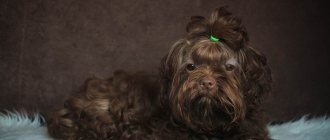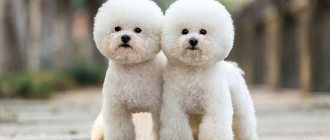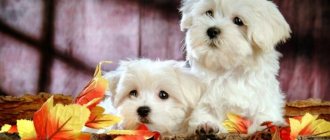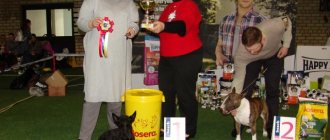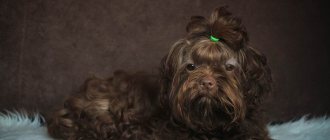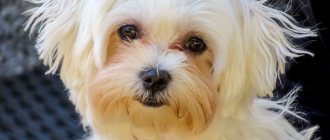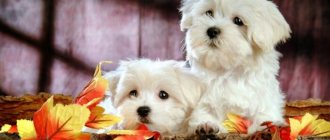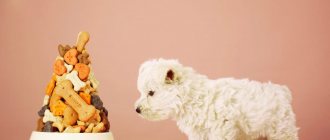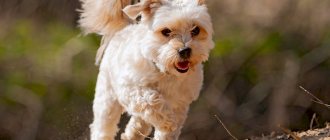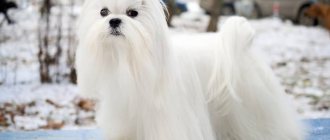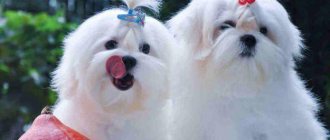Maltese in the winter is quite susceptible to cold, for this reason he gets sick, but not at all like the others - he coughs and sneezes
If you want to get yourself a small dog, then the Maltese or, as it is commonly called, the Maltese Bichon, would be an excellent option. This breed, and dogs are distinguished by their good nature, are not afraid to leave them to play with small children.
They often have good health indicators, and remain cheerful and cheerful until the end of their long and interesting lives. Such dogs are amazingly beautiful, they will be able to give their owner a lot of positive emotions and joy.
It is interesting that the Maltese Bichon does not at all justify the name assigned to it, since it appeared on the island of Melita, and not at all from the famous island of Malta. This breed of dog has been known to mankind since time immemorial; it was often depicted on ceramics and various tombstones of the Egyptians, as well as the Greeks and Romans, and this happened three thousand years ago. During the reign of the Roman Empire, a representative of this breed began to be called “Canis melitensis”, this name means “dog from the island of Melita”
For the reason that the name of this island is quite similar to the name of the popular island of Malta, starting almost from the 16th century, these dogs began to be called “Maltese”. Maltese finally completed its development in England, and from there it spread almost throughout the world.
General characteristics of the Maltese dog
The height of such a dog is from 21 to 23 cm. The weight of Maltese bichons, according to standard measurements, is no more than three or four kilograms.
The Maltese's head is of standard proportional dimensions, its skull is quite wide and has a rounded shape. The length of the muzzle itself is slightly less than the length of the skull; the transition from the head to the muzzle is quite clearly defined. The entire head is covered with a luxurious white coat, an ivory-colored pair that completely covers the dog's eyes and thus forms a kind of "whisker" as well as a "beard". The dog's nose is black and quite large in size. Some representatives of this breed have a straight bite, others have a scissor bite. Often the eyes are dark in color, quite large in size, with a surprisingly lively and intelligent expression on the face. Black eyelids are evidence of a purebred breed. The length of the ears varies, it can reach almost 8.5 cm. Their shape is triangular, often the pet’s ears are in a completely floppy state, they lie flat on both sides of the head, they are intensively covered with a huge amount of hair. The Maltese looks like a small, cute soft toy. The body is quite squat, slightly elongated. The dog's neck is positioned in such a way that at first glance it seems that it was deliberately bent a little back. The tail is set quite high, mainly on the croup itself, quite wide at the base, then gradually turns into an arch along its entire length. It is completely covered with thick, elegant hair, which gently falls to one side, reaching all the tips of the paws. The limbs of the Maltese are completely covered with white hair, and the front ones are completely straight with the strongest steep, angular pasterns, and in the hind legs they are extremely not clearly expressed. The paws are quite round in shape, peculiarly gathered into a ball, with soft pads of bright black color. The claws are dark in color.
When purchasing a dog of this breed, you will never regret your choice, since it is good not only on the outside, but also beautiful in its inner world, it loves affection, warmth and love not only to receive, but also to give.
Don’t waste your time, get a Maltese today and tomorrow you will be able to find a true friend who will be by your side for many years, giving only the most positive emotions.
FEDERATION CYNOLOGICAL INTERNATIONAL (FCI) STANDARD
Russia is an official member of the International Canine Federation (FCI), therefore the assessment and examination of Maltese at exhibitions is carried out according to the FCI standard.
General appearance
Small (dog) with a stretched body. The whole body is covered with very long, white hair, is extremely elegant, holds its head proudly and aristocratically (with self-esteem).
Important proportions
The length of the body is approximately a good third greater than the height at the withers (WRH). The length of the head corresponds to approximately half the height at the withers (WRH).
Head.
Its length corresponds to approximately half the height at the withers (WRH). It is quite wide, somewhat wider than half its length.
Scull.
The skull is slightly longer than the muzzle and also slightly wider than half the length of the head. The shape is slightly oval. The upper part of the skull is flat, the cheekbones are slightly pronounced.
Stop.
The protrusion of the forehead is well defined and forms an angle of 90 degrees.
Muzzle
Nose.
It is a continuation of the bridge of the nose. Large, with open nostrils, always black.
Mouth.
The length of the muzzle is 4/11 of the total length of the head; The muzzle should protrude forward and not look square. The bridge of the nose is horizontal.
Lips.
Lips are thin. The upper and lower lips are “matched” (so that the mucous membrane is not visible during examination). The edges of the lips should be completely black.
Jaws.
Normally developed, not strong (rough, strong), with perfect closure. The lower jaw should not protrude forward and should not lag behind the upper jaw.
Teeth.
The jaws fit together flawlessly to form a scissor bite. The teeth are white, regular in shape and in full set.
Eyes.
With a lively and attentive (intelligent) expression, slightly larger than usual, with a rounded cut. The eyelids fit tightly to the eyeballs. The eyes should not be sunken or too prominent. The whites of the eyes should not be visible (when viewed from the front). The color of the iris is dark brown; the edges of the eyelids are black.
Almost triangular. They are set high on a wide base, slightly raised and close to the head.
Despite the large amount of fur, it should be clearly visible from the back of the head. Its top line is curved, its length corresponding to approximately half the height at the withers (WRS). The neck is set straight, without visible folds of skin.
Torso.
Its length is a good third greater than the height at the withers (WRS).
Back line.
Straight to the very base of the tail. The withers are slightly raised.
Breast.
The chest is spacious and reaches slightly below the level of the elbows; The ribs are not too prominent. The chest circumference is 2/3 greater than the height at the withers (WRS).
Croup
Very wide and long.
Tail.
Set high on the rump, thick at the base, thin towards the tip. The length is approximately 69% of the height at the withers (WRS). The tail forms a large arch over the back, so that its tip touches the croup between the thigh bones. The tail can be curved to one side.
Limb sizes
Forelegs. Well fitting to the body, legs straight. Dry, with slightly noticeable muscles, but fairly strong bones. The length of the leg, from the pads of the feet to the elbow, corresponds to approximately 55% of the height at the withers (WRH). The bones of the forearms move freely, without thickness.
Paws.
Rounded, fingers tightly gathered into a ball. Paw pads and claws are black. The claws are uniformly black, or at least dark.
Hind limbs.
With strong (strong) bones, set parallel to each other, Hips with well-developed muscles. The forward angles of the hock joints are 140 degrees. The paws completely correspond to the front paws.
Movement.
Uniform, smooth and fast, free, with a short and very fast stride.
Leather.
Tight-fitting all over the body, with dark pigment spots. The edges (mucous membranes) of the eyelids and lips are black.
Coat.
A dense, shiny coat that flows in a luxurious, heavy mass and has a silky texture. Long throughout the body, and smooth along its entire length, without curls or waves. Falling heavily to the floor, like a mantle adjacent to the body, without falling into separate strands and forming curls.
Curly and shaggy hair is allowed only on the front legs, from elbows to paws, and on the hind legs, from knees to paws. There is no undercoat. The hair on the head is very long.
The hair growing on the back of the nose is mixed with the hair that forms the beard, the hair of the tuft is mixed with the hair growing on the ears. The hair that forms the hair of the tail falls from one side of the body and reaches the hock joint.
Color.
Pure white (snow white); Only the palest shade of ivory is permitted. Very limited shades of a very pale orange tone are also allowed, giving the impression of a dirty coat, and are therefore undesirable and represent an imperfection.
Behavior and character.
Lively, affectionate, the Maltese is very easy to train, a very intelligent decorative dog.
Size and weight.
Height at withers (WRH) for males: from 21 to 25 cm; height at withers (WRH) for bitches: from 20 to 23 cm; weight: from 2.9 to 4 kg.
Flaws.
Any deviation from the presented description of the breed can be considered as a defect, the assessment of which must be given in exact proportion to the degree of deviation; This is also valid for bilateral strabismus, and also if the length of the body exceeds the height at the withers (WRH) by 43% or more.
Vices.
A distinctly convex bridge of the nose, pronounced overshot or undershot. Males more than 26 or less than 19 cm, Bitches with height at withers (WRH) more than 25 or less than 18 cm.
Disqualification.
Marked divergence or convergence of the lines of the outlines of the skull and muzzle; depigmentation of the nose, or the nose is a color other than black. Undershot eyes, multi-colored eyes, complete depigmentation of the eyelid margins, congenital or acquired taillessness, or a stubby tail. Any color other than white, except the palest shade of ivory; individual pronounced spots, regardless of their size.
Note.
Males should have two apparently normal testicles fully descended into the scrotum.
A gentle dog with dazzling white fur, a gentle disposition and a sensitive character is a Maltese, Maltese Bichon or Maltese. Yes, yes, all three names denote a breed whose equal cannot be found in the whole world. Just 25 cm tall and weighing up to 3 kg, this amazing creature has all the abilities of a rat catcher, a canine companion and a charming home decoration.
Once you see a Maltese on a walk or in the hands of its owner, you will never be able to forget the dog. And it’s not even about the luxurious long fur that hangs like a blanket onto the hands or the ground, or the devoted gaze of slightly bulging eyes. The Maltese breed is a harmonious creation of nature itself, where all the features are united so tightly and tightly that it is impossible to add or subtract anything!
Differences from other dogs
The Bichon Frize differs from other breeds of small dogs due to its rather strong body. She has developed bones and a muscular back and hind legs.
Bichons are also much larger than Chihuahuas or Yorkshire terriers, so when playing with such a dog, the owner may not be afraid of hurting it. Bichons are active and intelligent dogs that are easy to train.
And unlike the Italian lapdog, the Bichon Frize is not so intrusive and does not require attention 24 hours a day. The Bichon's coat is richly white and looks like an airy cloud, in contrast to the Italian Balonese, whose coat resembles a curly fur coat.
Next, we will present the characteristics of such Bichon breeds as Havanese, Coton de Tulear, Lyon (aka Levchen or small lion dog), Bolognese (or Bolognese) and Maltese (or Maltese), and also show their photos.
Havanese Havanese
The dogs are small, reaching up to 29 cm in height at the withers and can weigh up to 6.7 kg. The head of the Havanese has a flattened round shape, the body is long, and the legs are short in comparison. The muzzle resembles the muzzle of a poodle, the same elongated one, the eyes are large and dark. Double wool, very soft. Long and wavy throughout the body.
The color of the coat can be not only light, but also dark, not monochromatic, but with spots of various colors.
Havaneses are not aggressive, but on the contrary, very friendly dogs that are easy to train.
Madagascar Coton de Tulear
Dogs that look very similar to lap dogs . Height is from 27 to 29 cm, and weight is from 3.6 to 5.8 kg. Their head is triangular in shape, their ears are long and drooping. Wide-set eyes, most often dark. The body is not particularly long, but stocky. Muscular back and legs.
There is long hair all over the body, but unlike the Bichon Frize, this breed has straight hair. Long, soft. The only color available is white. By nature, these dogs are friendly and smart, they easily make contact with both children and adults. Temperament is playful. They love to be outdoors and play outdoor games.
Lövchen got his nickname “lion dog” because of his haircut, which makes him look like a little lion cub. This breed is smaller than other lap dogs; its height can be no more than 26 cm, and its weight can be from 4 to 6 kg.
The Bichon Lyon is a playful, cheerful companion who loves outdoor walks and active games. The coat requires careful care; it needs to be combed every day and trimmed regularly.
Bolognese
The height of the Bolognese Bichon reaches 26-29 cm; weight - 4-5 kg. The country of origin of this breed is Italy. This small and cheerful dog is perfect for older people.
Unlike other representatives of lapdogs, the Bichon Bolognese does not like active games so much; on the contrary, the workload of such a dog is average. It is not recommended to overload them with physical exercise. The Bolognese Bichon's coat is silky and long, without undercoat. It is recommended to brush your dog three times a week.
Maltese
Maltese are the smallest of the Balonka section, their height is only 20-24 cm, and their weight is up to 4.5 kg. The Maltese has a wide head and large, round eyes. The coat is curly, dense, fluffy. The color is exclusively white, a shade of ivory is allowed.
These mini dogs are affectionate and kind, but also fearless. And in case of danger, they will certainly protect their owner. They are calm with other animals and love to play with children. But they are not willing to train, so in order to teach a Maltese any command, the owner will need patience.
The beauty of antiquity that has come down to us: the history of the breed
There is no precisely established information about the origin of the Maltese breed. But experts claim that dogs appeared on the island of Malta two thousand years ago, although the individuals were then called “melita” - in honor of the island. In the 1st century BC, several representatives of the breed came to China, and from there they moved to the New World with merchant ships.
As soon as Maltese puppies appeared in Europe, the dogs became wildly popular! Still would! The snow-white soft fur with a slightly creamy tint, the gentle character, humility and tenderness of the dogs melted the hearts of all royal families. Until the 16th century, the offering of a Maltese puppy meant favor and disposition towards the recipient.
It is interesting that the Knights of Malta, distinguished by their fearless character and incredible cruelty, favored these tiny Bichons and always took the Maltese with them. But they did not remain pet owners for long; it was customary to give Maltese puppies to the ladies of their hearts, leaving a long and good memory of themselves.
But be that as it may, with some digression it can be argued that the role of “parents of the breed” was toy spaniels, small poodles and other now extinct breeds of tiny dogs. Important: the Maltese is a very domestic dog, but when getting a pet, do not forget that initially all representatives did an excellent job of hunting rats and mice. And although today all Bichons are more likely to be domestic companions, they are still hunters!
You can be proud to bring a tiny bundle of happiness into your home! Maltese puppies are recognized favorites of all the royal courts of Europe. Mary Stuart, Queen Victoria, Louis IX, King Philip II of Spain, Grand Empress Catherine II and Elizabeth I - this is not a complete list of Maltese admirers. Today's celebrities also did not stand aside, paying tribute to the Maltese breed.
Tender, white, meek - description of the breed
A very small dog, covered with hair from head to toe, a gentle look with slightly bulging eyes and charming bangs gathered in ponytails - this is a Maltese dog. By bringing this baby into your home, you will certainly fall in love with him with all your heart and the Bichon will reciprocate completely.
But the pet will love not only you. All family members will be licked, caressed and listened to. If you are sad, the Maltese will climb into your arms and cheer you up; if you have no one to tell your troubles and joys, your pet will listen carefully and take your side! Wherever you go, to the kitchen or to the living room, you will not be left alone: the baby will always accompany you! But you should not assume that the Maltese is a quiet domestic animal. No!
The Maltese Bichon is fatally dependent on the mood and attention of the owner. If you do not devote enough time to your pet and do not play with it, your four-legged pet will begin to grow weak, get sick, and may even die. Do not leave Maltese puppies alone - this is strictly prohibited. Let it be your children, acquaintances or just friends, dogs are well received by both acquaintances and strangers.
Breed standards
If we isolate the characteristics of the breed, then the Maltese has a full list of advantages: friendliness, devotion, intelligence, obedience and good training abilities. But at the same time, you need to remember some disadvantages: complete intolerance to dampness and loneliness, fragility and some health problems, which you will learn about a little later.
According to the accepted classification of the International Kennel Club, any individual of the breed must meet the following standards:
- the build is harmonious, the length of the body should not be greater than the height at the withers;
- height no more than 25 cm, weight up to 3 kg. At the same time, ladies are slightly smaller than gentlemen;
- the head is never larger than 6/11 of the height at the withers, the shape of the head is slightly oval, but the line of the muzzle and forehead is clearly parallel;
- The large nose is always black, slightly moist and cold. The nostrils are well open;
- light, but well-developed jaws have a full set of white teeth, lips are black, dry, tightly fitting to the gums. Sagging or sagging lips are not allowed;
- the eyes are slightly convex, black, round in shape. The look is always intelligent, smart and kind;
- hanging ears are covered with long fur;
- the back is flat, straight, the chest is moderately convex, without dewlap or sharply protruding corners;
- the tail is slightly curved to the side, short and completely covered with hair;
- The paws are strong, even, the pads are firmly assembled.
In the entire description of the Maltese you will not find a single protruding element: this is a “even” dog in all respects. Starting from moderation in color (only solid white) to character. Interestingly, Maltese dogs shed extremely rarely, so they will be a real find for “brilliant housewives” and anyone who cannot stand fur on furniture and things.
Nutrition
What to feed your Bichon Frize? Puppy - natural products: in this case, the risk of allergies will be minimized. You can give your baby purees, cereals, fruits and vegetables. You need to exclude flour products, sausage, fatty and spicy foods, as well as citrus fruits and chocolate from your diet; chicken is very undesirable.
The menu for an adult pet includes vegetables, meat, and rolled oats. Only sea fish is allowed. It is necessary to include vitamins in the diet. Make sure your pet always has fresh water. An alternative option is a diet consisting of factory-made food of at least premium class.
If there is a significant deviation in the dog’s weight, you should immediately contact a veterinarian.
Breed care: groom and feed!
Bichons, like all small breeds, are very playful and active. But pets don’t need a lot of space to release their energy; your one-room apartment will do just fine. It is here that the pet will create its own playground and will completely calm down, running around the carpet and climbing on pillows. But still, you shouldn’t neglect some tips for caring for your four-legged pet.
1) Combing is the main problem. Infrequent shedding combined with a luxurious coat creates the risk of tangles. Therefore, it’s worth stocking up on a good hairstyle, patience and an hour of free time every day!
2) Walking is a prerequisite for good development. Twice a day, for about an hour and no less. Let it be leisurely walks in the park or your daily jog, it doesn’t matter. The main thing is to give your companion plenty of time to run and frolic.
3) Feeding will not cause any difficulty - Maltese dogs eat well both homemade porridge and dry canned food. But watch your portions, Bichons are prone to overeating.
4) Babies should be bathed no more than 5-6 times a year, but only when they are heavily soiled. The easiest and most reliable way is to use special products and be sure to dry your pet’s luxurious coat.
5) Cleaning ears and eyes - daily.
As you can see, your companion is quite unpretentious. Maltese dogs are great for both experienced dog owners and beginners. Don’t forget to constantly supervise your pet and teach it order, you will get a charming “bundle of happiness” for many, many years! By the way, there are never any problems with training; the Maltese is so happy to please its owner that it readily accepts all new skills!
Black lap dog
I will not describe the difference between a black Maltese and a white one for one simple reason. Such a thing simply does not exist at the moment . Once upon a time, the existence of two branches, black and white, was recognized, but then white finally won the hearts of dog breeders and is now recognized as a single, standard color. Those dogs that some dog lovers call the Black Maltese are actually a variety of the Russian Tsvetnaya Bolonka, a completely different breed.
Health problems
Despite their durability and rather “natural” appearance, Maltese dogs are sometimes susceptible to eye diseases, visual abnormalities, dental diseases and gum problems. Pets may also suffer from hypoglycemia, so it is worth studying the parents’ medical records.
A timely examination by a doctor, proper nutrition, walks and communication with the owner is all that a Maltese needs. And, of course, you can’t help but fall in love with this “white spirit with wet eyes”; you will never be able to punish the child for pranks. This look will melt even the coldest heart! The best part is that Bichons are the longest-lived breeds. Get a puppy at home and you are guaranteed 14-15 years of cloudless happiness!
Homeland and time of origin:
Mediterranean, Antiquity; height 20-25 cm, weight 2-3 kg
Description:
Maltese are gentle and sensitive small dogs whose bodies are covered with thick, dazzling white fur tinged with ivory. The Maltese also has huge, slightly protruding eyes.
Breed history:
There is no exact information about the origin of the breed. It is generally accepted that on the island of Malta 2000 years ago there lived dogs, the breed of which later became known as Melita (in honor of the island - this was the ancient name of Malta). Apparently, these dogs could be the progenitors of the modern Maltese breed. Experts believe; that small spaniels and toy poodles undoubtedly took part in the formation of the breed. Both before and now Maltese are used as companions.
Games, entertainment, recreation:
Maltese are very inventive and playful. Due to their small size, they can easily turn an apartment into a comfortable training ground for their fun. These dogs simply love exercise.
Attractive Features:
Maltese are unusually good-natured and gentle towards their owner and his family members. They are especially affectionate with children. Maltese is mortally dependent on the attention of its owner: if you do not give it enough attention and leave it alone for a long time, this dog’s heart will not stand it! The Maltese, it should be noted, perceives strangers and other dogs quite calmly.
Health problems:
The most commonly reported symptoms are visual impairment, damage to teeth and gums, and hypoglycemia.
Please note that your dog’s diet must include a fair amount of dry food; otherwise, the Maltese's digestion may be upset. In conclusion, we add that Maltese are predisposed to bronchial asthma. When choosing a puppy, be careful, take your time, and carefully study the parents' medical records.
Content Features:
The Maltese needs plenty of activity and your attention.
The luxurious fur of these amazing animals deserves special mention. Since the dog practically does not shed, there is a serious possibility of matting. To avoid this, daily thorough brushing is recommended.
Miscellaneous:
The average lifespan of a Maltese is about 14 years.
Breed traits (on a 5-point scale)
| Activity | in the house | 3,3 |
| on the street | 2,9 | |
| Obedience | training | 3,4 |
| strangers | 3,5 | |
| Domination | in family | 1,9 |
| over dogs | 2,2 | |
| Defending your territory | from people | 2,1 |
| from dogs | 1,8 | |
| Sociability | in family | 4,8 |
| with strangers | 3,8 | |
| with dogs | 3,4 | |
| Concentration | in family | 1,3 |
| in front of strangers | 2,2 | |
| with dogs | 2,7 | |
| Aggressiveness | in family | 1,3 |
| to strangers | 1,4 | |
| to the dogs | 1,8 | |
| to cats | 1,8 | |
| Family behavior | calmness | 3,9 |
| demand for affection | 4,3 | |
| excitability | 4,2 | |
| playfulness | 4,3 | |
| excessive barking | 2,5 | |
| behavioral breakdowns | 1,3 | |
| Tolerance for children | up to 4 years | 3 |
| over 4 years old | 3,7 | |
| Institutional use | watchman | 4 |
| bodyguard | 1,2 |
Classification
| FCI: | Group 9 Section 1 Bichons and related breeds |
| AKC: | Companion Dog (Toy) |
| ANKC: | Group 1 Companion Dog (Toys) |
| CKC: | Group 5 Companion Dog (Toys) |
| KC(UK): | Companion Dog (Toy) |
| NZKC: | Companion Dog (Toy) |
| UKC: | Companion Breeds |
Juliet May "All about the most popular dog breeds"
The Bichon Frize is a lapdog from France, which, thanks to its spectacular appearance, has become popular all over the world.
Outwardly, they look like soft plush toys and have a surprisingly good-natured character. They quickly become attached to their owner and love children very much. They easily adapt to different conditions, can live in apartments of different sizes and love to be the center of attention. They need careful care.
The current standard appeared in 1988. A distinctive feature that has become characteristic of these dogs is curly hair.
Here are more detailed characteristics that belong to this breed.
The head is proportional to the body, the forehead is flat.
Round, dark eyes set straight. The muzzle is strong, shorter than the skull, the lips fit tightly to each other, the upper lip completely covers the lower one. The teeth are straight, scissor bite. The nose is round and black. The ears hang on the sides of the muzzle, are not very long, and are covered with hair.
Rectangular body.
Straight, strong and wide back.
The neck is flexible and rounded. The chest is well developed, wide and deep.
The tail is located at the level of the spine, is of medium length, and covered with long hair.
The limbs are strong, with well-developed muscles.
The front legs are parallel, set close to the body, rounded and dense, with black claws.
Important!
The color can only be white!
Coat type and length. The coat of these dogs is very long, soft, silky to the touch, and constantly tends to curl into spiral curls. They have a fairly soft and thick undercoat, which protects them from sudden temperature changes.
The weight is the same for both males and females. These dogs weigh from three to five kilograms.
The size is different.
For males it varies from twenty-five to thirty centimeters, for females - from twenty-three to twenty-nine centimeters.
Bichon varieties
In nature, there are several varieties of lapdogs, which are similar not only in appearance, but also in character.
The only difference between them is their countries of origin and growth.
Famous bichons include:
- Havanese (havanese);
- Bolognese (Bolognese dog);
- Maltese (Maltese dog);
- lövchen (lion dog);
- Coton de Tulear (Madagascar Bichon);
- Russian lap dog;
- lowen.
General Traits of Bichons
The varieties of this dog breed have a lot in common. They are all small in size, most of the dogs are only white in color, they are all very cute, beautiful and unusual in appearance. Besides this, they have the same characters.
Reference
. All Bichons are friendly, sociable, active, playful and have a strong love for children, as well as making excellent companions.
The difference between Bichon Frize and other dogs
The main difference is the special approach to caring for the frieze. They need a professional haircut.
It is recommended to take dogs to brush regularly. Their diet is special; the owner must know the list of foods that his pet cannot tolerate. Beautiful snow-white dogs require more careful coat care. It is necessary to ensure that there are no traces of tears left on the face, and to wipe the ears and mouth.
How do related breeds differ?
Related breeds are often very similar to each other, but they have their own minor differences. Let's look at each of these breeds:
- The Havanese
(Hawaiian Bichon) originates from Cuba.
Their distinctive feature is their shaggy appearance.
His long hair is not cut, but is left to fall over his face and give the appearance of a beard. The color can be very different: in addition to white, blue, cream and chestnut are allowed. - The Coton de Tulear (Madagascar Bichon)
is a relative of the Bichon Frize, so they have almost no differences.
The only difference is the wool.
In Frize it is curly, in Coton it is straight and long. In addition to white color, ivory color is allowed. - The Lion Bichon
originated in France.
The difference is in the haircut.
Lion's haircut is unusual, giving him the image of a lion; the hind limbs are cut very short, as well as the base of the tail. The head and body are covered with abundant fluffy hair; they look royal thanks to this haircut. They also differ in color, combining different colors: from black to white, ash, and some representatives of the breed can even be spotted. - The Bichon Bolognese
is a toy dog native to Northern Italy.
It is from them that the Bichon Frize originated. This beautiful little dog has a cheerful, playful character and is an excellent companion, like all lap dogs. Differs from other related bichons in easier care.
She does not need a haircut, just brush her coat regularly and wash it more often, since her color is pure white. - The Maltese Bichon
(Maltese) originated from the island of Mljet.
It has a snow-white color and soft long hair, which requires daily grooming due to the lack of undercoat. Only the paws are curly. Their main differences are their character and size.
These are the most affectionate and gentle representatives of the breed, and are also very small. Their maximum weight reaches only three kilograms.
Which Bichon is better?
Each of them is a worthy representative. But the most popular and beloved is the Bichon Frize. Children love him because he is playful and affectionate, and adults are attracted by the kindness in the eyes of these dogs and their unusually cute appearance.
Important!
When taking your dog home, keep in mind that he needs to be constantly entertained, always given attention, and occupied with walks and games. Don't offend him!
There are many different stories from the owners of these dogs that if you yell at them or offend them, then all the feelings and emotions that this white bundle of happiness is currently experiencing will be immediately depicted on their face. And if he harbors a grudge against you, he will immediately show it with his hooligan actions
.
Historical reference
The Bichon Frize (translated as “curly Bichon”), like the Poodle, is a descendant of the Barbet (Water Spaniel), hence the name “Barbichon”, and later shortened to “Bichon”.
The Bichon Frize was brought to France from Italy during the Renaissance. At that time, four varieties were distinguished: Tenerife, Maltese, Bolognese and Havana bichons.
Later, these dogs won the hearts of the French and Spanish nobility, bore the proud title of “dog-infanta,” and their images are often found in the paintings of Francisco Goya (1746-1828). Owning a Bichon was considered a sign of good taste. In the 17th and 18th centuries, famous artists depicted these small dogs next to kings, nobles and other famous personalities.
It is known that the King of France, Henry III, was a great admirer of the breed.
The breed came back into fashion during the time of Napoleon III and was known at that time as the Tenerife Bichon. It was soon popularized and became a favorite in Belgium and France. The breed practically disappeared after two world wars, and only thanks to a few breeders in France and Belgium it was possible to preserve and revive the breed's population.
The first dog registered in Belgium, named Pitou, born on March 23, 1924, was registered in the Belgian stud book in 1932. The first number in the French stud book was the dog Ida, a Bichon Frize female, registered on October 18, 1934. The modern French name - Bichon a Poile Frize - was assigned in 1978, and the breed itself is recognized as Franco-Belgian.
Mixed breeds
The history of the origin of these four-legged beauties has not been fully studied. There are several different opinions about who these dogs were crossed with.
Some say that there was a crossover with the poodle, with the barbet.
Others say that Bichons were crossed with the Bolognese to breed several types of lapdogs. There is also an opinion that the Maltese was crossed with different dogs.
Attention!
When buying a puppy, you may be deceived and sold as a mixed breed. To be completely sure that you are purchasing a purebred dog, visit exhibitions and kennels. There you will be presented with documents for the animal, and you will know that the money you paid was not in vain.
Aristocratic, French, purebred, looking like a delicious marshmallow, the dog personifies perfection itself. She is charming, smart and can become a real adornment, a loyal friend and companion to any lady from a wide range of age categories. If you have this miracle at home, try to treat it the same way you treat children. Dogs are very sensitive and fully reflect the attitude of a person.
Be kind to them, sociable and always pay attention to your pet. Bichons do not like to be left alone.
Which one is better to choose?
When choosing a decorative dog, the buyer's choice often falls on Bichons. If the potential buyer has children, this is the most suitable dog. But which Bichon breed is best?
The most prone to training is the Bichon Frize. Also, thanks to its rather large build, the Bichon Frize can play with children without harm to its health.
Dogs that perfectly meet the standards are sent to exhibitions, so if a dog will participate in exhibitions, then it must be purchased with all documents and vaccinations, of course, without defects in body structure and coat color.
